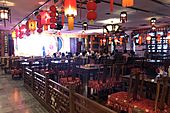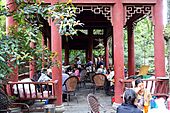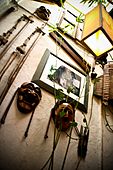East Asian tea ceremony facts for kids
Quick facts for kids East Asian tea ceremony |
|||||||
|---|---|---|---|---|---|---|---|

A Japanese female hostess performs a tea ceremony.
|
|||||||
| Chinese name | |||||||
| Chinese | 茶道 | ||||||
|
|||||||
| Alternative Chinese name | |||||||
| Traditional Chinese | 茶藝 | ||||||
| Simplified Chinese | 茶艺 | ||||||
|
|||||||
| Second alternative Chinese name | |||||||
| Traditional Chinese | 茶禮 | ||||||
| Simplified Chinese | 茶礼 | ||||||
|
|||||||
| Korean name | |||||||
| Hangul | 다도 | ||||||
| Hanja | 茶道 | ||||||
|
|||||||
| Japanese name | |||||||
| Kanji | 茶道 | ||||||
|
|||||||
An East Asian tea ceremony is a special way of making and serving tea in countries like China, Japan, and Korea. It's more than just drinking tea; it's a cultural activity with special steps and traditions.
In Chinese, it's called Chádào (茶道), which means "way of tea." In Japanese, it's Chadō (茶道), and in Korean, it's Dado (다도). All these names mean something like "way of tea," "tea etiquette," or "art of tea."
These ceremonies are a way to appreciate beauty in everyday life. They involve being refined, humble, and simple. They also have an artistic side with special symbols and forms.
At its basic level, an East Asian tea ceremony is a very careful way of making tea. This process has been perfected over many years to make the tea taste its very best. Old books like the Chinese The Classic of Tea from the 8th century helped shape these traditions.
Contents
Tea Ceremonies in East Asia
China
In China, a tea house (茶室 cháshì) is a traditional place where people gather. It's a bit like a coffee shop, but for tea! People go to tea houses to chat, meet friends, play games like xiangqi or Go, and enjoy different kinds of tea. Young people often meet there for dates too.
Japan
In Japan, a tea house is usually a special building called a chashitsu (茶室). This building is designed just for holding Japanese tea ceremonies. The entrance to this special place is called a roji (露地). The chashitsu is made to help people feel calm and thoughtful.
The Japanese tea ceremony combines two main ideas: wabi (侘) and sabi (寂).
- Wabi is about inner feelings. It means being quiet, simple, and humble. It celebrates simple things and the beauty that comes with age.
- Sabi is about the outer world and how things are not perfect. It's about seeing the natural beauty in things, even if they are old or worn.
Zen Buddhism has greatly influenced the Japanese tea ceremony. The ceremony teaches harmony with nature and self-improvement. It's a way to enjoy tea in a formal or informal setting. It helps people appreciate imperfection and find spiritual calm. Tea drinking is also used to help with meditation.
Japanese tea gardens were created a long time ago, between the 1300s and 1600s. They are designed to be a peaceful setting for the tea ceremony. The path to the teahouse, called the roji, helps visitors relax and prepare their minds. There's an outer garden where guests wait, and an inner garden where they wash their hands and rinse their mouths. This is similar to how people prepare before entering a Shinto shrine. The path is always kept moist and green, like a quiet mountain path. There are no bright flowers to distract visitors from their thoughts.
Korea
In Korea, the traditional tea ceremony is called Darye (다례; 茶禮). The Korean way of tea is often more relaxed and natural. It has fewer strict rules than some other ceremonies. This allows for more freedom and creativity in how tea is enjoyed. People can try different teas, use various teaware styles, and have different conversations. This also means Korean tea houses, gardens, and snacks can vary a lot from place to place and season to season.
Gallery
- East Asian Teahouses
-
A Japanese teahouse from the Edo period
-
Gyokusenen in Kanazawa, Ishikawa prefecture, Japan
Tea Traditions Around the World
Tea drinking is popular all over the world, not just in East Asia. In the United Kingdom, especially during the Victorian era, afternoon tea was a big social event. It was important to have the right equipment, good manners, and the right people around. This tradition was also influenced by Indian tea culture.
In the United States, tea traditions started with the Dutch colonization of the Americas. In the early colonies, tea was served with fancy silver strainers, beautiful porcelain cups, and special tea pots. In recent years, more Americans have become interested in fine teas. This happened especially after 1971, when China started exporting tea again. Before that, it was hard for Americans to get much Chinese or Indian tea.
See also
 In Spanish: Ceremonia del té para niños
In Spanish: Ceremonia del té para niños







